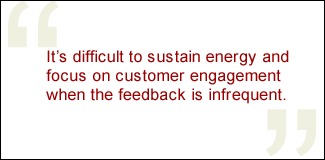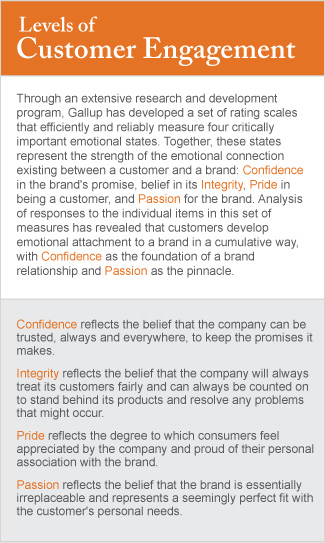It's tough to exaggerate the importance of customer engagement. Fully engaged customers deliver a 23% premium over average customers in share of wallet, profitability, revenue, and relationship growth, according to Gallup research, while actively disengaged customers represent a 13% discount on the same measures. Furthermore, workgroups that are in the top 25% based on their levels of customer engagement outperform the rest on measures of profit, sales, and growth by a factor of two to one.
 |
So, considering the amount of money on the line, it pays to scrutinize every single customer-employee encounter. That's exactly why so many call centers survey customers to determine their level of engagement.
But what happens between measurements? At best, customer service representatives (CSRs) see their customer scores once a month. Many CSRs only get their scores quarterly or annually. It's difficult to sustain energy and focus on customer engagement when the feedback is infrequent. The challenge for team leaders and managers becomes finding ways to keep CSRs committed to engaging their customers, even when new data isn't available. Specifically, how can team leaders keep customer engagement from feeling like an isolated event, rather than a way of doing business?
The good news is that each day provides opportunities to tackle some aspect of customer engagement, because every single employee-customer conversation results in a teachable moment. Reminding CSRs of what customers need emotionally, then examining those needs in the context of real phone calls, keeps CSRs attuned to engaging customers. And, there's an easy way to do this: Focus on customers' emotions.
An emotional experience
Gallup has found that there is a four-level hierarchy of emotional attachment that describes how customers form relationships with products, brands, and services. The hierarchy begins with confidence, then moves through levels of integrity and pride, and culminates in passion. (For definitions of the four levels, see graphic "Levels of Customer Engagement.")
 |
To coach CSRs regarding day-to-day customer interactions, remind them that their customers' emotional needs can only be fulfilled by someone who is attuned to those needs. And that's not as difficult as it sounds, especially for CSRs with a talent for interacting with customers. In fact, there are several straightforward techniques that team leaders can use to help CSRs build emotional attachment among their customers.
Confidence
Customers can only feel confident about a product, service, or brand if it keeps its promises every day for every customer. CSRs must listen closely to each person on the phone to determine if there's a discrepancy between a customer's expectation and his or her experience of the brand promise. There are three key situations in which CSRs have an opportunity to instill brand confidence:
- Recognize customers' vulnerability . Making customers feel protected rather than taken advantage of is crucial to creating trust. Have CSRs practice listening for areas of vulnerability. Then have them practice easing those concerns.
- Reassure customers. CSRs should assure customers that they are handling any problems -- by informing them of any actions taken, if appropriate, or by otherwise putting customers at ease. Specifically, if a CSR plans on taking certain steps to address a customer's problem, the CSR should explain what he or she is going to do for the customer, and why.
- Resolve the issue on the first call. Good listening skills, being knowledgeable, and knowing when to escalate a call are all keys to building customer confidence. But the best way to fulfill the brand promise is by resolving any issues on the very first call.
Integrity
The customer may not always be right -- but customers should be allowed to be wrong with dignity. CSRs can convey brand integrity by handling every transaction respectfully and in a way that resolves issues fairly. Here are a few specific methods for fostering brand integrity:
- Look for CSR knowledge gaps. There may be some calls or interactions that a CSR isn't comfortable handling because he or she needs more information or doesn't quite understand the problem. Ask each CSR, "If there is one type of call (or transaction) that, if you had your way, you would never handle again, what would it be?" Coaching may help CSRs become more adept at handling these interactions.
- Educate customers; don't patronize or lecture. CSRs should inform customers about actions that they have taken on the customers' behalf, and -- if customers are receptive -- give them tips to help them learn how to avoid a similar problem in the future. But remember: Angry or frustrated customers may not want to listen to helpful hints. They may need an opportunity to vent their frustrations before the CSR starts the problem-solving process.
- Be accountable -- and communicate. CSRs should tell customers the process the CSR is going through to resolve the issue. No customer wants to feel lost in the void.
- Apologize, but don't make excuses. CSRs should never say something like, "I would help you if it were up to me, but they won't let me." That will convey the opposite of integrity.
Pride
The brand that a customer uses is both a reflection of who the customer is and how he or she wants to be viewed. Whenever customers say, "I am your best customer," "I have a perfect payment history," or "Your product is the only one I buy," they are expressing pride. There are three simple ways to reinforce this bond with customers:
 |
- Compliment customers on their history, if appropriate. CSRs should praise customers for things like their perfect payment history, renewals, what a great customer they've been, and how often they return.
- Be as excited as customers are about their purchases. Help CSRs understand that they are more than a voice on the phone. Ultimately, they are the brand to a customer. They should be as proud of the brand and product as the customer is. (See "Unleash Your Brand Ambassadors" in the "See Also" area on this page.)
- Support customers' desire to feel competent and in control. For example, CSRs should look for opportunities to make customers aware of ways that they can more fully manage their account or find ways to make better choices. At the same time, CSRs should always look for reasons to compliment customers on their choices when it makes sense to do so.
Passion
Passion is the highest level of emotional engagement. Passionate customers can't imagine a world without the brand, service, or product, and they would rather go without than switch to a competitor. Passionate customers want to feel like they receive individualized service, or even that they are the only customers of the brand. Passionate customers are the most valuable of all to your organization, and they should be recognized as such. Here's how:
- Treat customers as individuals. A CSR should never say, "Well, that's just how we do things here," or "I don't understand -- other customers are fine with that." And a CSR should never flatly state the company policy without an explanation.
- Don't rush customers. Your customers' time is as important as your CSRs' time. Hustling them off the phone won't increase their engagement.
- Make sure CSRs are engaged. Disengaged CSRs don't create passionate customer relationships and may in fact drive people away. Start by measuring your call center employees' engagement. The results will give you a baseline for where your engagement levels are and crucial insights into what might be hindering engagement -- and into what is already working well. (See "Creating an Employee-Centric Call Center" and "Start Calling on Your Call Centers" in the "See Also" area on this page.)
Aim for passion
There are many ways that call center managers can help CSRs maintain their focus on customer engagement, even in the absence of frequent customer feedback. When coaching CSRs, managers should concentrate on keeping the customers' emotions in mind and aiming to create passionate customer relationships with every interaction. So, in general:
- Use role playing when coaching CSRs. Role playing, especially when the CSR plays the customer, can help drive home key points.
- Bring questions, not answers. When coaching CSRs, share some ideas and hypotheses based on their results, but allow CSRs to discover for themselves what they do well and how they can improve.
- Don't neglect areas of strength. If all you do is try to fix CSRs' weaknesses, you will slowly and painfully make them mediocre. Instead, try to help CSRs make the most of their innate talents when handling customers' problems. Some CSRs may be more effective using a relationship-oriented approach, while others may be more analytical when working with customers. Concentrate on the outcomes you want the CSRs to achieve, then let them use their natural style to get there. (See "Coaching Talent" in the "See Also" area on this page.)
- Remember: The customer's focus should be on the brand, not the CSR. An interaction that leaves a customer feeling happy with the CSR but angry about the brand is a bad experience. Remind CSRs that the purpose of the interaction is not to improve what the customer thinks of the CSR. The purpose is for the CSR to bolster what the customer thinks of the brand. One of the worst things a CSR can say to a customer is "I would love to help you, but my company's policies prevent me from doing so," or "I know this doesn't make sense, but it's the way we do things here."
There are many drawbacks associated with infrequent customer feedback. One is that managers and CSRs can lose focus on building customer engagement, which can result in a loss of happy customers. Another is that when CSRs receive customer engagement scores only once or twice a year, promoting customer engagement feels like a one-time event, rather than a regular business practice. The key is keeping customers -- and customer engagement -- top of mind for every CSR every day.